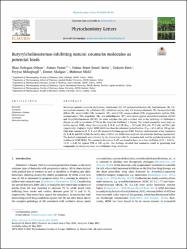| dc.contributor.author | Erdoğan Orhan, İlkay | |
| dc.contributor.author | Tosun, Fatma | |
| dc.contributor.author | Şenol Deniz, Fatma Sezer | |
| dc.contributor.author | Eren, Gökçen | |
| dc.contributor.author | Mıhoğlugil, Feyyaz | |
| dc.contributor.author | Akalgan, Demet | |
| dc.contributor.author | Miski, Mahmut | |
| dc.date.accessioned | 2021-06-04T06:02:09Z | |
| dc.date.available | 2021-06-04T06:02:09Z | |
| dc.date.issued | 2021 | en_US |
| dc.identifier.citation | Erdoğan Orhan, İ., Tosun, F., Şenol Deniz, F. S., Eren, G., Mıhoğlugil, F., Akalgan, D. ... Miski, M. (2021). Butyrylcholinesterase-inhibiting natural coumarin molecules as potential leads. Phytochemistry Letters, 44, 48-54. https://dx.doi.org/10.1016/j.phytol.2021.05.001 | en_US |
| dc.identifier.issn | 1874-3900 | |
| dc.identifier.issn | 1876-7486 | |
| dc.identifier.uri | https://dx.doi.org/10.1016/j.phytol.2021.05.001 | |
| dc.identifier.uri | https://hdl.handle.net/20.500.12511/7029 | |
| dc.description.abstract | Seventeen natural coumarin derivatives; badrakemin (1), 14′-acetoxybadrakemin (2), badrakemone (3), 14′-acetoxybadrakemone (4), colladonin (5), colladonin acetate (6), 14′-acetoxycolladonin (7), karatavicinol (8), deltoin (9), smyrnioridin (10), marmesin (11), osthol (12), oxypeucedanin (13), oxypeucedanin hydrate (14), isoimperatorin (15), scopoletin (16), and umbelliprenin (17), were tested against acetylcholinesterase (AChE) and butyrylcholinesterase (BChE), the sister enzymes that play a critical role in the pathology of Alzheimer's disease as well as tyrosinase (TYR) as the target for Parkinson's disease. The tested coumarins were more selective against BChE, where the coumarins 2, 5, 8, and 15 (IC50 = 30.3 μM, 29.2 μM, 37.2 μM, and 50.1 μM, respectively) displayed higher BChE inhibition than the reference (galanthamine, IC50 = 60.2 μM) at 100 μg/mL. Only four coumarins (2, 5, 9, and 15) showed inhibition against AChE. Binding conformations of the coumarins (2, 5, 8, 9, and 15) within the active sites of AChE and BChE were explored via molecular docking experiments. The docked compounds were oriented by the interactions with the oxyanion hole and the peripheral anionic site residues of AChE/BChE. The coumarin derivatives 1–17 was found to have no or low inhibition (2.03 ± 0.92 %–12.91 ± 0.40 %) against TYR at 100 μg/mL. Our findings revealed that coumarins could be promising lead compounds for designing novel anti-Alzheimer drug candidates. | en_US |
| dc.language.iso | eng | en_US |
| dc.publisher | Elsevier Ltd | en_US |
| dc.rights | info:eu-repo/semantics/embargoedAccess | en_US |
| dc.subject | Alzheimer's Disease | en_US |
| dc.subject | Cholinesterase | en_US |
| dc.subject | Coumarin | en_US |
| dc.subject | Molecular Docking | en_US |
| dc.subject | Tyrosinase | en_US |
| dc.title | Butyrylcholinesterase-inhibiting natural coumarin molecules as potential leads | en_US |
| dc.type | article | en_US |
| dc.relation.ispartof | Phytochemistry Letters | en_US |
| dc.department | İstanbul Medipol Üniversitesi, Eczacılık Fakültesi, Eczacılık Meslek Bilimleri Bölümü, Farmakognozi Ana Bilim Dalı | en_US |
| dc.authorid | 0000-0003-2533-5141 | en_US |
| dc.identifier.volume | 44 | en_US |
| dc.identifier.startpage | 48 | en_US |
| dc.identifier.endpage | 54 | en_US |
| dc.relation.publicationcategory | Makale - Uluslararası Hakemli Dergi - Kurum Öğretim Elemanı | en_US |
| dc.identifier.doi | 10.1016/j.phytol.2021.05.001 | en_US |
| dc.identifier.wosquality | Q3 | en_US |
| dc.identifier.scopusquality | Q2 | en_US |


















